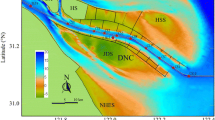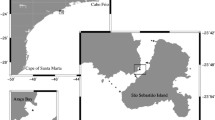Abstract
Underway current velocity profiles were combined with temperature and salinity profiles at fixed stations to describe tidal and subtidal flow patterns in the middle of the northernmost Chilean fjord, Estuario Reloncaví. This is the first study involving current velocity measurements in this fjord. Reloncaví fjord is 55 km long, 2 km wide, and on average is 170 m deep. Measurements concentrated around a marked bend of the coastline, where an 8-km along-fjord transect was sampled during a semidiurnal tidal cycle in March 2002 and a 2-km cross-fjord transect was occupied, also during a semidiurnal cycle, in May 2004. The fjord hydrography showed a relatively thin (<5 m deep), continuously stratified, buoyant layer with stratification values >4 kg m−3 per meter of depth. Below this thin layer, the water was relatively homogeneous. Semidiurnal tidal currents had low amplitudes (<10 cm s−1) that allowed the persistence of a surface front throughout the tidal cycle. The front oscillated with a period of ca. 2.5 h and showed excursions of 2 km. The front oscillations could have been produced by a lateral seiche that corresponds to the natural period of oscillation across the fjord. This front could have also caused large (2 h) phase lags in the semidiurnal tidal currents, from one end of the transect to the other, within the buoyant layer. Tidal phases were relatively uniform underneath this buoyant layer. Subtidal flows showed a 3-layer pattern consisting of a surface layer (8 m thick, of 5 cm s−1 surface outflow), an intermediate layer (70 m thick, of 3 cm s−1 net inflow), and a bottom layer (below 80 m depth, of 3 cm s−1 net outflow). The surface outflow and, to a certain extent, the inflow layer were related to the buoyant water interacting with the ambient oceanic water. The inflowing layer and the bottom outflow were attributed to nonlinear effects associated with a tidal wave that reflects at the fjord's head. The weak subtidal currents followed the morphology of the bend and caused downwelling on the inside and upwelling on the outside part of the bend.
Similar content being viewed by others
Literature Cited
Bathurst, J. C., C. R. Thorne, andR. D. Hey. 1977. Direct measurements of secondary currents in river bends.Nature 269:504–506.
Cáceres, M., A. Valle-Levinson, andL. Atkinson. 2003. Observations of cross-channel structure of flow in an energetic tidal channel.Journal of Geophysical Research 108:3114, doi:10.1029/2001JC000968.
Cáceres, M., A. Valle-Levinson, H. H. Sepulveda, andK. Holderied. 2002. Transverse variability of flow and density in a Chilean fjord.Continental Shelf Research 22:1683–1698.
Chant, R. J. andR. E. Wilson. 1997. Secondary circulation in a highly stratified estuary.Journal of Geophysical Research 102: 23207–23215.
Edwards, K. A., P. MacCready, J. N. Moum, G. Pawlak, J. M. Klymak, andA. Perlin. 2004. Form drag and mixing due to tidal flow past a sharp point.Journal of Physical Oceanography 34:1297–1312.
Geyer, W. R. 1993. Three-dimensional tidal flow around headlands.Journal of Geophysical Research 98:955–966.
Geyer, W. R. andR. Signell. 1990. Measurements of tidal flow around a headland with a shipboard acoustic Doppler current profiler.Journal of Geophysical Research 95:3189–3197.
Ianniello, J. P. 1977. Tidally induced residual current in estuaries of constant breadth and depth.Journal of Marine Research 35:755–786.
Ianniello, J. P. 1978. Tidally induced residual current in estuaries of variable breadth and depth.Journal of Physical Oceanography 9: 962–974.
Joyce, T. M. 1989. On in situ calibration of shipboard ADCPs.Journal of Atmospheric Oceanic Technology 6:169–172.
Lacy, J. andS. Monismith. 2001. Secondary currents in a curved, stratified estuarine channel.Journal of Geophysical Research 106: 31283–31302.
Lacy, J., M. Stacey, J. R. Burau, and S. Monismith. 2003. Interaction of lateral baroclinic forcing and turbulence in an estuary.Journal of Geophysical Research 108: doi:10.1029/2002JC001392.
León, J. E. 2005. Influencia del caudal del Río Puelo sobre la salinidad y la concentración de oxígeno disuelto en el Estuario de Reloncaví, Llanquihue, Chile, M.S. Thesis. Universidad Austral de Chile, Valdivia, Chile.
Lwiza, K. M. M., D. G. Bowers, andJ. H. Simpson. 1991. Residual and tidal flow at a tidal mixing front in the North Sea.Continental Shelf Research 11:1379–1395.
Malone, T. C., W. M. Kemp, H. W. Ducklow, W. R. Boynton, J. H. Tuttle, andR. B. Jonas. 1986. Lateral variation in the production and fate of phytoplankton in a partially stratified estuary.Marine Ecology Progress Series 32:149–160.
Milliman, J. D., C. Rutkowski, andM. Meybeck. 1995. River discharge to the sea. A global river index (GLORI). LOICZ Reports and Studies, Texel, The Netherlands.
Niemeyer, H. andP. Cereceda. 1984. Hidrografia, p. 1–313.In I. G. Militar (ed.), Geografía de Chile, Volume VIII. Instituto Geografía de Chile, Santiago, Chile.
Parker, B. B. 1991. The relative importance of the various nonlinear mechanisms in a wide range of tidal interactions (review) p. 237–268.In B. Parker (ed.), Tidal Hydrodynamics. John Wiley and Sons, New York.
Seim, H., J. O. Blanton, andT. Gross. 2002. Direct stress measurements in a shallow, sinuous estuary.Continental Shelf Research 22:1565–1578.
Seim, H., andM. Gregg. 1997. The importance of aspiration and channel curvature in producing strong vertical mixing over a sill.Journal of Geophysical Research 102:3451–3472.
Signell, R., andW. R. Geyer. 1991. Transient eddy formation around headlands.Journal of Geophysical Research 96:2561–2575.
Soto, D., andF. Norambuena. 2004. Evaluation of salmon farming effects on marine systems in the inner seas of southern Chile: A large-scale mensurative experiment.Journal of Applied Ichthyology 20:493–501.
Souza, A. J., andJ. H. Simpson. 1996. The modification of tidal ellipses by the stratification in the Rhine ROFI.Continental Shelf Research 16:997–1007.
Stigebrandt, A. 1977. On the effect of barotropic current fluctuations on the two-layer transport capacity of a constriction.Journal of Physical Oceanography 7:118–122.
Svendsen, H., andR. O. R. Y. Thompson. 1978. Wind-driven circulation in a fjord.Journal of Physical Oceanography 8:705–712.
Thorne, C. R., andR. D. Hey. 1979. Direct measurements of secondary currents at a river inflexion point.Nature 280:226–228.
Valle-Levinson, A., andL. Atkinson. 1999. Spatial gradients in the flow over an estuarine channel.Estuaries 22:179–193.
Valle-Levinson, A., andJ. L. Blanco. 2004. Observations of wind influence on exchange flows in a strait of the Chilean Inland Sea.Journal of Marine Research 62:721–741.
Author information
Authors and Affiliations
Corresponding author
Rights and permissions
About this article
Cite this article
Valle-Levinson, A., Sarkar, N., Sanay, R. et al. Spatial structure of hydrography and flow in a Chilean fjord, Estuario Reloncaví. Estuaries and Coasts: J ERF 30, 113–126 (2007). https://doi.org/10.1007/BF02782972
Received:
Revised:
Accepted:
Issue Date:
DOI: https://doi.org/10.1007/BF02782972




